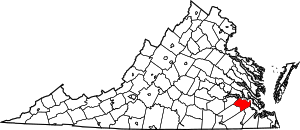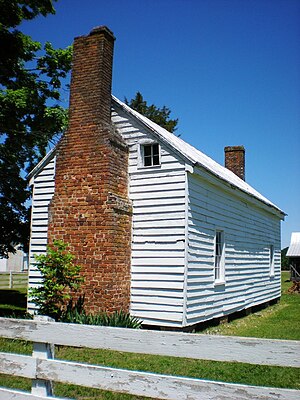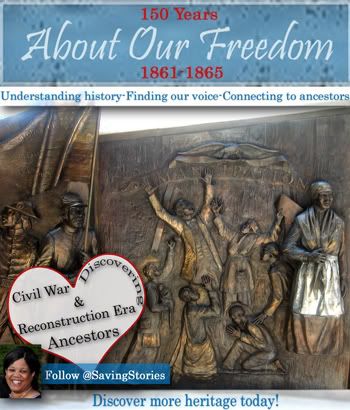McGill engages with youth and community at Bacon's Castle
What a great experience it was must have been for Joe go the extra mile and dress in his Civil War uniform for the children in the Surry County School system who attended his lecture. I am sure he brought history alive for them. Thank you for what you do, Joe! Next, we will bring you the accounts of some of the participants from The Slave Swelling Project stay at Bacon's Castle. So, stay tuned!
Robin Foster
About Our Freedom
McGill engages with youth and community at Bacon's Castle
By Joseph McGill, Jr. | Field Officer | Charleston Field Office
National Trust for Historic Preservation | William Aiken House l 456 King Street, 3rd Floor, Charleston, South Carolina 29403 |
After a 3 month hiatus, the Slave Dwelling Project came back
strong with two stays in Virginia. The
first of the stays was Bacon’s Castle which occurred on Friday, October 5,
2012. Constructed in 1665 in Surry
County on the south side of the James River, Bacon Castle is the oldest brick
structure in North America. Best known
for its connection to the Bacon’s Rebellion, it was home to Arthur Allen, his
heirs, and other planters and their families from the seventeenth to the
twentieth century.
 |
| Map of Virginia highlighting Surry County (Photo credit: Wikipedia) |
When the Slave Dwelling project was in its infancy, I got a
visit in my Charleston office of the National Trust for Historic Preservation
from staff members of Preservation Virginia.
They thought that the project would go over well at Bacon’s Castle. I remember being impressed that even at that
early stage the project had gained enough relevancy to garner the attention of
this statewide organization. I vaguely
remember telling Jennifer Hurst, Associate Director for Museum Operations and
Education, that my time spent with them should be maximized. That part of the conversation came across to
her loud and clear because maximizing my time is exactly what she did. As a result of Jennifer’s planning, the
project directly interacted with more people than any other stay to date. Let me explain.
Community interaction
With the date chosen, it would still be about a year before
the stay would occur. That time was
utilized quite effectively with Jennifer planning and promoting the project on
her end and me on mine. Social media
played a big role in the buildup to the stay most notably yielding at least one
guest that would share the stay at Bacon’s Castle. About two weeks prior to the trip, I had an
interview from a Surry County, Virginia newspaper reporter which resulted in a newspaper
article. An additional notice of the
stay was printed in the local paper on the day the stay occurred. My ongoing involvement with the group, Coming
to the Table (CTTT), would also play a big role in this stay.
| English: Preservation Virginia Logo (Photo credit: Wikipedia) |
My first direct action with the Bacon’s Castle stay would
occur in Richmond, VA. Jennifer arranged
for me to spend my first night at historic Linden Row Inn. I was the honored dinner guest of members of
the board of directors of Preservation Virginia. I had the pleasure of giving them a synopsis
of the Slave Dwelling Project. I praised
them for making Virginia state number twelve for the Slave Dwelling Project.
In planning the events associated with the sleepover at
Bacon’s Castle, Jennifer insisted that I bring my Civil War uniform. After explaining to Jennifer that when I fly
to the sleepovers I lighten my carryon luggage by not bringing my Civil War
uniform but she continued to insist with her reason being that I was going to
address children in the Surry County school system. Address the children I did, senior high,
middle school and 3rd and 4th graders! It was an overall great experience as I
adjusted the message to accommodate the age of the children that I addressed at
the time. The students, some of whom had
visited Bacon’s Castle the day before, responded accordingly with highly
intelligent and engaging questions in the end.
While presenting to the first school group, Toni Battle of
San Francisco and Devin Berry of Oakland, California showed up. I was expecting them. I met both of them in March of this year at
the national gathering of Coming to the Table.
Devin was my roommate while in Richmond and vowed that he would join me
in a future stay. Being a man of his
word, Bacon’s Castle would be that stay.
Toni made it clear in Richmond that the ancestors are with me on this project
even if I am in denial. Both Toni and
Devin and one other Coming to the Table member, Prinny Anderson would spend the
night in the slave cabin at Bacon’s Castle.
Day of the stay
Arriving at Bacon’s Castle on the day of the stay was not
the first time for me but it was for Toni and Devin. The three of us arriving together proved
invaluable because the photographic documentation began instantly, an important
element that had been missing in this project to date. Although I had been in the slave cabin
before, having the pleasure of witnessing Toni and Devin experience the space
for the first time was quite moving.
Containing four rooms on two levels, the structure is the only one of
eighteen slave cabins left on the property and is situated among several other
out buildings. Jennifer’s planning
ensured that in a matter of hours seventeen people would occupy the two lower
levels. Jennifer had already apprised me
of the guest list and the one of which I was most skeptical was that of the
media representative for I have been burned by that promise many times before.
In an attempt to strengthen the relationship between Bacon’s
Castle and the African American community, early in the planning of this event,
Jennifer and I decided others should be given the opportunity to share the
slave dwelling experience with me. In
addition to the local people scheduled to stay that night, people from North
Carolina, Texas and California were also scheduled to stay. Early in the evening, as we gathered in the
big house, the people started to show: Barbara and Judy Anderson, two sisters
whose great-great grandmother was once enslaved at Bacon’s Castle; Michael Ray
Vines, Jr. a student at Virginia State University, Reverend Daniel Baltimore,
the Pastor of Mt. Nebo Baptist Church in Surry; Allison T. Williams a reporter
for the Daily Press and a host of others.
 |
| External building at Bacon's Castle (Photo credit: Wikipedia) |
Ghost stories seemed to permeate the conversation but it became obvious
that the local African American community rarely interacted with Bacon’s
Castle. Hearing the testimonials of why
they all chose to spend the night in the slave cabin at Bacon’s Castle was
verification to me of why the Slave Dwelling Project was necessary. Of all those testimonies, none meant more to
me than the fact that I was sharing the experience with the Anderson sister
whose great-great grandmother was enslaved at Bacon’s Castle.
After moving the group to the cabin, we all claimed our spot
on the floor where we would place our sleeping bags to bed down for the
night. On the porch of the cabin, a live
video streaming and live chat were attempted.
The chat was successful the video streaming failed. Time was then allowed for Toni Battle to
conduct smudging which is blessing the space inside the cabin before we all
moved outside again to form a circle for the pouring of libation as we were all
reminded that this occasion was about honoring the ancestors.
Cotton field talk
The following day was full of activities as demonstrations
and presentations were planned throughout.
Early that morning, before the audience began to arrive, one totally
unplanned event happened. Devon Berry,
Toni Battle, Prinny Anderson and me, all members of Coming to the Table, found ourselves at the cotton field bordering
Bacon’s Castle. Although cotton was not
the crop of which the enslaved at Bacon’s Castle labored, it was comforting
that me and Devon, the descendants of slaves; Toni Battle, the descendant of
slaves and whose ancestors were the subjects of lynching; and Prinny Anderson a
descendant of Thomas Jefferson could all gather in a cotton field on a
plantation to talk about the subject of slavery and the healing process.
It was even more comforting that on our way
back from that visit to the cotton field, we encountered one of the Anderson
sisters whose ancestor was once enslaved at Bacon’s Castle. We learned from Mrs. Anderson that because of
her opportunity to spend a night in the cabin, more opportunities for
interacting with Bacon’s Castle now exist, more specifically, her becoming a volunteer
tour guide and discussing with the rest of the family the possibility of having
a family reunion on the property.
Personally that alone would be mission accomplished for the Slave
Dwelling Project but there was more to come.
Period cooking
The most noted presenter of the day was Harold Caldwell an employee
of Colonial Williamsburg who demonstrated period cooking. It was a pleasure to observe him as he
interacted with his audience. His method
of engaging them at every opportunity was inspiring to me. Sampling his creations was an added
bonus. When I told him about my one
experience of cooking beef stew in a slave cabin and the critique I got about
slaves not having access to beef, he made me aware that it really depended on
the plantation owner and that there are accounts of some masters issuing their
slave beef or other meat products. The
overall experience with Mr. Caldwell has certainly opened my mind to similar
programs at other slave dwellings in the future.
The hat
It was a pleasure for me to interact with the people who
came out to partake in the activities planned for the day. I had three occasions to address the visitors
about the Slave Dwelling Project. I used
the occasion to yield some time to some of the other people who shared the
experience the prior night and to Jennifer to speak specifically about the
history of the cabin and slavery at Bacon’s Castle. During the question and answer period after
the second presentation. I got the
question, “Can you tell my mom about the hat?”
Initially the question was confusing to me because I was not wearing a
hat at the time but then Jennifer immediately came to the rescue. Earlier that morning, I asked Jennifer if it
was necessary that I wear the Civil War uniform, she replied that it was
totally up to me, I chose not to. After
hearing the question, Jennifer reminded me that the young student asking the
question was a part of the school presentation the previous day and he
remembered the hat that I wore with the Civil War uniform. His question was great on many fronts:
methods of living history work, i.e. wearing period uniforms; the young man was
successful in convincing his mother to bring him to the event; and Jennifer
Hurst was right in insisting that I bring the Civil War uniform.
 |
| Bacon's Castle was occupied by Bacon's followers during the rebellion (Photo credit: Wikipedia) |
The Bacon’s Castle experience alone would put Virginia in
the category of most exciting and engaging state for the Slave Dwelling Project
thus far but before I left Virginia there was one more stay to be done. Next blog: Sweet Briar College, Sweet Briar,
Virginia.
.jpg)
.jpg)


























0 comments